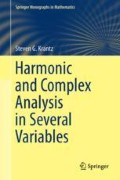Abstract
One of the big contributions of E. M. Stein is the development of harmonic analysis on the Heisenberg group. In a fundamental joint paper with G. B. Folland, Stein laid all the groundwork for this study. In this chapter we reproduce and develop some of that groundwork. We contrast classical analysis on Euclidean space with the new analysis on the Heisenberg group.
In particular we treat the noncommutativity of the Heisenberg group. We develop the idea of homogeneous dimension. We prove results about fractional integrals. And we learn about commutators of vector fields.
Access this chapter
Tax calculation will be finalised at checkout
Purchases are for personal use only
Notes
- 1.
Suffice it to say that a group is nilpotent of step m if all mth order commutators in the group equal the identity—and if m is the least such integer. In particular, an abelian group is nilpotent of step 1.
- 2.
It must be noted, however, that the rotations on the disc and the translations on the upper half plane do not “correspond” in any natural way; certainly the Cayley transform does not map the one group to the other. This anomaly is explored in the fine text [HOF, Ch. 3, 8].
- 3.
We use here the classical terminology of Siegel upper half spaces. Such an upper half space is defined with an inequality using a quadratic form. The resulting space is unbounded. However, when the quadratic form is positive definite then the domain has a bounded realization—that is to say, it is biholomorphically equivalent to a bounded domain. See [KAN, Ch. 1, 7] for details of this theory.
- 4.
In some sense it is more natural to consider commutators in the Lie algebra of the group. By way of the exponential map and the Campbell–Baker–Hausdorff formula (see [SER, Ch. 4]), the two different points of view are equivalent. We shall describe some of the Lie algebra approach in the material below. For now, the definition of commutators in the context of the group is a quick-and-dirty way to get at the idea we need to develop right now.
Bibliography
S. Bell, Biholomorphic mappings and the \(\overline{\partial }\)-problem, Ann. Math., 114(1981), 103–113.
R. R. Coifman and G. L. Weiss, Analyse harmonique non-commutative sur certains espaces homogénes, Lecture Notes in Mathematics, Vol. 242. Springer–Verlag, Berlin-New York, 1971.
H. Federer, Geometric Measure Theory, Springer-Verlag, New York, 1969.
G. B. Folland, Spherical harmonic expansion of the Poisson–Szegö kernel for the ball, Proc. Am. Math. Soc. 47(1975), 401–408.
G. B. Folland and E. M. Stein, Estimates for the \(\overline{\partial }_{b}\) complex and analysis on the Heisenberg group, Comm. Pure Appl. Math. 27(1974), 429–522.
G. B. Folland and E. M. Stein, Hardy Spaces on Homogeneous Groups, Mathematical Notes, 28. Princeton University Press, Princeton, N.J.; University of Tokyo Press, Tokyo, 1982.
D. Geller, Fourier analysis on the Heisenberg group, Proc. Nat. Acad. Sci. USA 74(1977), 1328–1331.
D. Geller, Fourier analysis on the Heisenberg group, Lie Theories and their Applications, Queen’s University, Kingston, Ontario, 1978, 434–438.
D. Geller, Fourier analysis on the Heisenberg group. I. Schwarz space, J. Functional Anal. 36(1980), 205–254.
D. Geller and E. M. Stein, Convolution operators on the Heisenberg group, Bull. Am. Math. Soc. 6(1982), 99–103.
S. Helgason, Differential Geometry and Symmetric Spaces, Academic Press, New York, 1962.
K. Hoffman, Banach Spaces of Holomorphic Functions, Prentice-Hall, Englewood Cliffs, NJ. 1962.
Kaneyuki, Homogeneous Domains and Siegel Domains, Springer Lecture Notes #241, Berlin, 1971.
A. Knapp and E. M. Stein, Intertwining operators for semisimple groups, Ann. of Math. 93(1971), 489–578.
S. Kobayashi, Hyperbolic Manifolds and Holomorphic Mappings, Marcel Dekker, New York, 1970.
A. Koranyi and S. Vagi, Singular integrals in homogeneous spaces and some problems of classical analysis, Ann. Scuola Norm. Sup. Pisa 25(1971), 575–648.
S. G. Krantz, Function Theory of Several Complex Variables, 2nd ed., American Mathematical Society, Providence, RI, 2001.
S. G. Krantz, A Panorama of Harmonic Analysis, Mathematical Association of America, Washington, D.C., 1999.
S. G. Krantz, Lipschitz spaces on stratified groups, Trans. Am. Math. Soc. 269(1982), 39–66.
A. Nagel and W. Rudin, Local boundary behavior of bounded holomorphic functions, Can. Jour. Math. 30(1978), 583–592.
L. P. Rothschild and E. M. Stein, Hypoelliptic differential operators and nilpotent groups, Acta Math. 137 (1976), 247–320.
W. Rudin, Function Theory in the Unit Ball of \(\mathbb{C}^{n}\), Springer, Berlin, 1980.
J.-P. Serre, Lie algebras and Lie groups, Lectures given at Harvard University, 1964, W. A. Benjamin, Inc., New York-Amsterdam, 1965.
E. M. Stein, Harmonic Analysis: Real-Variable Methods, Orthogonality, and Oscillatory Integrals, with the assistance of Timothy S. Murphy, Princeton University Press, Princeton, NJ, 1993.
E. M. Stein, Singular Integrals and Differentiability Properties of Functions, Princeton University Press, Princeton, NJ, 1970.
H. Whitney, Analytic extensions of differentiable functions defined in closed sets, Trans. Amer. Math. Soc. 36(1934), 63–89.
Author information
Authors and Affiliations
Rights and permissions
Copyright information
© 2017 Springer International Publishing AG
About this chapter
Cite this chapter
Krantz, S.G. (2017). The Heisenberg Group. In: Harmonic and Complex Analysis in Several Variables. Springer Monographs in Mathematics. Springer, Cham. https://doi.org/10.1007/978-3-319-63231-5_3
Download citation
DOI: https://doi.org/10.1007/978-3-319-63231-5_3
Published:
Publisher Name: Springer, Cham
Print ISBN: 978-3-319-63229-2
Online ISBN: 978-3-319-63231-5
eBook Packages: Mathematics and StatisticsMathematics and Statistics (R0)

